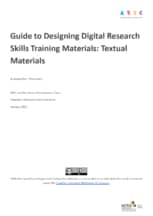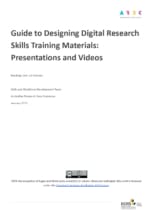
Guide to Designing Digital Research Skills Training Materials
Need help designing digital research skills training materials? Whether you’re developing a textual guide, presentation or video, this self-assessment tool can help you align your material’s format and content with best practices.
Designing Textual Materials
This is a quick checklist of key elements to include in your textual digital research skills training material. For explanations and examples of the elements, please refer to the corresponding sections of our full Guide to Designing Digital Research Skills Training Materials: Textual Materials.
Format
When you think about how your material should be formatted, always think in terms of how it will be received by your reader. This ensures the greatest accessibility and user experience. Consider the following aspects:
Your material should have:
- an easy-to-read typeface
- a large enough typeface
- strong colour contrast for texts and images.
Follow your organisation’s branding guidelines and use their templates.
Your material should have:
- captions or descriptions for non-decorative images
- clear link(s) between images and their explanations
- visual representations of ideas and concepts, where possible.
Be sure to:
- explain all acronyms and abbreviations full
- use the active voice
- use plain English
- link specific calls-to-action to the intended destinations and put them at the end of sentences – use concise keywords for the text and avoid generic phrases like “click here”
- use numerals for 2 and above.
- explain all technical terms
- provide a glossary (for guides with 6 or more technical terms).
Refer to your organisation’s editorial style guide (if available).
To ensure the greatest readability, it’s important to deliver your information in digestible chunks. You should:
- group similar ideas together
- break long paragraphs up into smaller ones
- simplify sentence with more than 2 points
- use bullet points instead of sentences where appropriate
- use headings and subheadings.
Your material should:
- have the same points of reference and terminology throughout
- have uniform formatting (formats, fonts, colours) throughout
- be left-aligned throughout.

Content
Maximise the impact of your material at each stage – from beginning to end and beyond – by signposting, refining and distributing it. Consider the following aspects:
Make sure that at the outset of your material, you state:
- the expected reading time
- any essential prior knowledge or pre-learning
- the purpose of the guide
- the targeted outcomes
- the target audience(s)
- the areas to be covered by the material in an overview.
You are likely to use examples in your material. Make sure they are:
- used to concretise explanations of unfamiliar topics
- current and relevant
- authentic.
At the end of your material, remember to:
- recap key ideas
- include a cheat sheet for complex content
- direct audience to sources for further information
- list any call-to-action.
When your material is ready, take some time to review it. At this stage, you want to fine-tune your draft and ensure that there are no gaps in the communication loop. You should:
- include relevant resources in your material
- trial the material
- meet approvals and sign-offs, if any.
Extend the impact of your material by distributing it. When doing so:
- follow your organisation’s guidelines for the sharing of resources.
- consider sharing your material through Digital Research Skills Australasia (DReSA).

Designing Presentations or Videos
This is a quick checklist of key elements to include in your digital research skills training presentation or video. For explanations and examples of the elements, please refer to the corresponding sections of our full Guide to Designing Digital Research Skills Training Materials: Presentations and Videos.
Format
When you think about how your presentation or video should be formatted, always think in terms of how it will be received by your audience. This ensures the greatest accessibility and user experience. Consider the following aspects:
Your presentation or video should have:
- an easy-to-read typeface
- a large enough typeface
- a reasonable pace with sufficient reading time between slides
- strong colour contrast for texts and images
- captions or descriptions for non-decorative images
- clear link(s) between images and their explanations
- ideas and concepts presented visually where possible
- bullet points instead of sentences where appropriate
- subtitles or captioning enabled
- a script included in the notes beneath the slides (for presentations)
- a transcript (for videos).
In terms of the audio, make sure:
- the volume is consistently at an audible level
- instructions are delivered at a reduced, deliberate pace
- the presenter speaks clearly
- the presentation or video is free of noise.
Your presentation or video should have:
- the same points of reference and terminology throughout
- uniform formatting (formats, fonts, colours) throughout
- a consistent pace.
If you are using external virtual spaces in live presentations, be sure to:
- provide multiple modes of access to external platforms, such as QR codes, links in chat
- demonstrate or explain how to use external engagement platforms (such as Mentimeter and Slido) or breakout rooms
- make post-activity arrangements – inform participants of where they should go and when.
Be sure to:
- explain all acronyms and abbreviations in full – visually (on the slide) and verbally
- use plain English
- use numerals for 2 and above
- explain all technical terms.

Content
Maximise the impact of your presentation or video at each stage – from beginning to end and beyond – by signposting, refining and distributing it. Consider the following aspects:
Make sure that at the outset of your presentation or video:
- the audience is introduced to the presenter(s)
- the audience is introduced to the topic
- essential prior knowledge or pre-learning is clearly stated
- the rationale behind your materials is given
- the learning objectives or audience buy-in is established.
You are likely to use examples in your presentation or video. Make sure they are:
- used to concretise explanations of unfamiliar topics
- current and relevant
- authentic.
In your presentation or video, be sure to:
- include an overview (for longer presentations)
- flag changes in focus areas through consistent use of transition slides
- flag transitions to another topic with discourse markers
- verbally and visually flag key ideas for the audience.
At the end of your presentation or video, remember to:
- recap key ideas
- present calls-to-action visually and verbally
- direct audience to sources for further information.
When your presentation or video is ready, take some time to review it. At this stage, you want to ensure that the content and technical elements are working as they should and that there are no gaps in the communication loop. You should:
- include relevant resources in your material
- trial the presentation or video
- refine it based on the feedback
- meet approvals and sign-offs, if any.
Extend the impact of your presentation or video by distributing it. When doing so:
- follow your organisation’s guidelines for the sharing of resources.
- consider sharing your material through Digital Research Skills Australasia (DReSA).

Next Step
The ARDC has developed a more detailed guidance document to help digital research skills trainers design textual materials and design presentations and videos, respectively. For explanations and examples of the elements listed above, please refer to the corresponding sections of the two documents.
-
View and Download in Zenodo
ARDC Ltd. (2023). Guide to Designing Digital Research Skills Training Materials: Textual Materials.
DOI: 10.5281/zenodo.7587650
-
View and Download in Zenodo
ARDC Ltd. (2023). Guide to Designing Digital Research Skills Training Materials: Presentations and Videos.
DOI: 10.5281/zenodo.7587656
Did you find this resource useful?
Receive tailored updates on latest digital research news, events, resources, career opportunities and more.
You may also be interested in
Last updated
Type
Categories
Research Topic
Related Program
Related Projects
Related Case Studies



